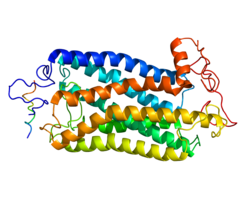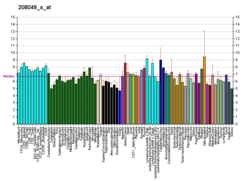The tachykinin receptor 1 (TACR1) also known as neurokinin 1 receptor (NK1R) or substance P receptor (SPR) is a G protein coupled receptor found in the central nervous system and peripheral nervous system. The endogenous ligand for this receptor is Substance P, although it has some affinity for other tachykinins. The protein is the product of the TACR1 gene.
Properties
Tachykinins are a family of neuropeptides that share the same hydrophobic C-terminal region with the amino acid sequence Phe-X-Gly-Leu-Met-NH2, where X represents a hydrophobic residue that is either an aromatic or a beta-branched aliphatic. The N-terminal region varies between different tachykinins. The term tachykinin originates in the rapid onset of action caused by the peptides in smooth muscles.Substance P (SP) is the most researched and potent member of the tachykinin family. It is an undecapeptide with the amino acid sequence Arg-Pro-Lys-Pro-Gln-Gln-Phe-Phe-Gly-Leu-Met-NH2. SP binds to all three of the tachykinin receptors, but it binds most strongly to the NK1 receptor.
Tachykinin NK1 receptor consists of 407 amino acid residues, and it has a molecular weight of 58,000. NK1 receptor, as well as the other tachykinin receptors, is made of seven hydrophobic transmembrane (TM) domains with three extracellular and three intracellular loops, an amino-terminus and a cytoplasmic carboxy-terminus. The loops have functional sites, including two cysteines amino acids for a disulfide bridge, Asp-Arg-Tyr, which is responsible for association with arrestin and, Lys/Arg-Lys/Arg-X-X-Lys/Arg, which interacts with G-proteins. The binding site for substance P and other agonists and antagonists is found between the second and third transmembrane domains. The NK-1 receptor is found on human chromosome 2 and is located on the cell's surface as a cytoplasmic receptor.
Distribution and function
The NK1 receptor can be found in both the central and peripheral nervous system. It is present in neurons, brainstem, vascular endothelial cells, muscle, gastrointestinal tracts, genitourinary tract, pulmonary tissue, thyroid gland and different types of immune cells. The binding of SP to the NK1 receptor has been associated with the transmission of stress signals and pain, the contraction of smooth muscles and inflammation. NK1 receptor antagonists have also been studied in migraine, emesis and psychiatric disorders. In fact, aprepitant has been proved effective in a number of pathophysiological models of anxiety and depression. Other diseases in which the NK1 receptor system is involved include asthma, rheumatoid arthritis and gastrointestinal disorders.
Mechanism
SP is synthesized by neurons and transported to synaptic vesicles; the release of SP is accomplished through the depolarizing action of calcium-dependent mechanisms.
When NK1 receptors are stimulated, they can generate various second messengers, which can trigger a wide range of effector mechanisms that regulate cellular excitability and function. One of those three well-defined, independent second messenger systems is stimulation, via phospholipase C, of phosphatidyl inositol, turnover leading to Ca mobilization from both intra- and extracellular sources. Second is the arachidonic acid mobilization via phospholipase A2 and third is the cAMP accumulation via stimulation of adenylate cyclase. It has also been reported that SP elicits interleukin-1 (IL-1) production in macrophages, it is known to sensitize neutrophils and enhance dopamine release in the substantia nigra region in cat brain. From spinal neurons, SP is known to evoke release of neurotransmitters like acetylcholine, histamine and GABA. It is also known to secrete catecholamines and play a role in the regulation of blood pressure and hypertension. Likewise, SP is known to bind to N-methyl-D-aspartate (NMDA) receptors by eliciting excitation with calcium ion influx, which further releases nitric oxide. Studies in frogs have shown that SP elicits the release of prostaglandin E2 and prostacyclin by the arachidonic acid pathway, which leads to an increase in corticosteroid output.
In combination therapy, NK1 receptor antagonists appear to offer better control of delayed emesis and post-operative emesis than drug therapy without NK1 receptor antagonists. NK1 receptor antagonists block responses to a broader range of emetic stimuli than the established 5-HT3 antagonist treatments. It has been reported that centrally-acting NK1 receptors antagonists, such as CP-99994, inhibit emesis induced by apomorphine and loperimidine, which are two compounds that act through central mechanisms.
Clinical significance
This receptor is considered an attractive drug target, particularly with regards to potential analgesics and anti-depressants. It is also a potential treatment for alcoholism and opioid addiction. In addition, it has been identified as a candidate in the etiology of bipolar disorder. Finally NK1R antagonists may also have a role as novel antiemetics and hypnotics.
Ligands
Many selective ligands for NK1 are now available, several of which have gone into clinical use as antiemetics.
Agonists
- GR-73632 - potent and selective agonist, EC50 2nM, 5-amino acid polypeptide chain. CAS# 133156-06-6
Antagonists
- Aprepitant
- Casopitant
- Elinzanetant
- Ezlopitant
- Fosaprepitant
- Lanepitant
- Maropitant
- Vestipitant
- L-733,060
- L-741,671
- L-742,694
- RP-67580 - potent and selective antagonist, Ki 2.9nM, (3aR,7aR)-Octahydro-2-[1-imino-2-(2-methoxyphenyl)ethyl ]-7,7-diphenyl-4H-isoindol, CAS# 135911-02-3
- RPR-100,893
- CP-96345
- CP-99994
- GR-205,171
- TAK-637
- T-2328
See also
Further reading
-
Burcher E (June 1989). "The study of tachykinin receptors". Clinical and Experimental Pharmacology & Physiology. 16 (6): 539–543. doi:10.1111/j.1440-1681.1989.tb01602.x. PMID 2548782. S2CID 30578296.
-
Kowall NW, Quigley BJ, Krause JE, Lu F, Kosofsky BE, Ferrante RJ (July 1993). "Substance P and substance P receptor histochemistry in human neurodegenerative diseases". Regulatory Peptides. 46 (1–2): 174–185. doi:10.1016/0167-0115(93)90028-7. PMID 7692486. S2CID 54379670.
-
Patacchini R, Maggi CA (October 2001). "Peripheral tachykinin receptors as targets for new drugs". European Journal of Pharmacology. 429 (1–3): 13–21. doi:10.1016/S0014-2999(01)01301-2. PMID 11698023.
-
Saito R, Takano Y, Kamiya HO (February 2003). "Roles of substance P and NK(1) receptor in the brainstem in the development of emesis". Journal of Pharmacological Sciences. 91 (2): 87–94. doi:10.1254/jphs.91.87. PMID 12686752.
-
Fong TM, Yu H, Huang RR, Strader CD (December 1992). "The extracellular domain of the neurokinin-1 receptor is required for high-affinity binding of peptides". Biochemistry. 31 (47): 11806–11811. doi:10.1021/bi00162a019. PMID 1280161.
-
Fong TM, Huang RR, Strader CD (December 1992). "Localization of agonist and antagonist binding domains of the human neurokinin-1 receptor". The Journal of Biological Chemistry. 267 (36): 25664–25667. doi:10.1016/S0021-9258(18)35657-6. PMID 1281469.
-
Fong TM, Anderson SA, Yu H, Huang RR, Strader CD (January 1992). "Differential activation of intracellular effector by two isoforms of human neurokinin-1 receptor". Molecular Pharmacology. 41 (1): 24–30. PMID 1310144.
-
Takahashi K, Tanaka A, Hara M, Nakanishi S (March 1992). "The primary structure and gene organization of human substance P and neuromedin K receptors". European Journal of Biochemistry. 204 (3): 1025–1033. doi:10.1111/j.1432-1033.1992.tb16724.x. PMID 1312928.
-
Walsh DA, Mapp PI, Wharton J, Rutherford RA, Kidd BL, Revell PA, et al. (March 1992). "Localisation and characterisation of substance P binding to human synovial tissue in rheumatoid arthritis". Annals of the Rheumatic Diseases. 51 (3): 313–317. doi:10.1136/ard.51.3.313. PMC 1004650. PMID 1374227.
-
Gerard NP, Garraway LA, Eddy RL, Shows TB, Iijima H, Paquet JL, Gerard C (November 1991). "Human substance P receptor (NK-1): organization of the gene, chromosome localization, and functional expression of cDNA clones". Biochemistry. 30 (44): 10640–10646. doi:10.1021/bi00108a006. PMID 1657150.
-
Hopkins B, Powell SJ, Danks P, Briggs I, Graham A (October 1991). "Isolation and characterisation of the human lung NK-1 receptor cDNA". Biochemical and Biophysical Research Communications. 180 (2): 1110–1117. doi:10.1016/S0006-291X(05)81181-7. PMID 1659396.
-
Takeda Y, Chou KB, Takeda J, Sachais BS, Krause JE (September 1991). "Molecular cloning, structural characterization and functional expression of the human substance P receptor". Biochemical and Biophysical Research Communications. 179 (3): 1232–1240. doi:10.1016/0006-291X(91)91704-G. PMID 1718267.
-
Giuliani S, Barbanti G, Turini D, Quartara L, Rovero P, Giachetti A, Maggi CA (October 1991). "NK2 tachykinin receptors and contraction of circular muscle of the human colon: characterization of the NK2 receptor subtype". European Journal of Pharmacology. 203 (3): 365–370. doi:10.1016/0014-2999(91)90892-T. PMID 1723045.
-
Ichinose H, Katoh S, Sueoka T, Titani K, Fujita K, Nagatsu T (August 1991). "Cloning and sequencing of cDNA encoding human sepiapterin reductase--an enzyme involved in tetrahydrobiopterin biosynthesis". Biochemical and Biophysical Research Communications. 179 (1): 183–189. doi:10.1016/0006-291X(91)91352-D. PMID 1883349.
-
Thöny B, Heizmann CW, Mattei MG (March 1995). "Human GTP-cyclohydrolase I gene and sepiapterin reductase gene map to region 14q21-q22 and 2p14-p12, respectively, by in situ hybridization". Genomics. 26 (1): 168–170. doi:10.1016/0888-7543(95)80101-Q. PMID 7782081.
-
Fong TM, Cascieri MA, Yu H, Bansal A, Swain C, Strader CD (March 1993). "Amino-aromatic interaction between histidine 197 of the neurokinin-1 receptor and CP 96345". Nature. 362 (6418): 350–353. Bibcode:1993Natur.362..350M. doi:10.1038/362350a0. PMID 8384323. S2CID 4339311.
-
Derocq JM, Ségui M, Blazy C, Emonds-Alt X, Le Fur G, Brelire JC, Casellas P (December 1996). "Effect of substance P on cytokine production by human astrocytic cells and blood mononuclear cells: characterization of novel tachykinin receptor antagonists". FEBS Letters. 399 (3): 321–325. doi:10.1016/S0014-5793(96)01346-4. PMID 8985172. S2CID 84912440.
-
De Felipe C, Herrero JF, O'Brien JA, Palmer JA, Doyle CA, Smith AJ, et al. (March 1998). "Altered nociception, analgesia and aggression in mice lacking the receptor for substance P". Nature. 392 (6674): 394–397. Bibcode:1998Natur.392..394D. doi:10.1038/32904. PMID 9537323. S2CID 4324247.
External links
|
|
|---|
| History |
|
| Biology |
|
| Symptoms |
|
| Treatment |
|
| Notable people |
|
| Popular culture |
|
| Related |
|







